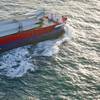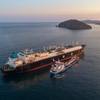The Executive Control Board of the National Shipbuilding Research Program Advanced Shipbuilding Enterprise (NSRP ASE) announced the selection of eight new Ship Production Panel Projects, totaling approximately $500,000. The Navy’s sponsors this program as a means to help reduce the cost in building and maintaining its fleet. A brief description of each project along with sponsoring panel follows:
Business Case Outline and Commodity Material Standardization Process: The intent of this project is to create a consistent, verifiable business case outline and process that can be applied to any specific situation that requires analyses for cost benefit and investment. Shipyards need a standard detailed business case outline and a repeatable process that can calculate the costs and benefits of making changes. This project will utilize current data and situations as the basis for creating a standard business case outline and process by addressing the problem that vendors of raw stock part numbers (e.g., shapes and pipe) must address - carrying a wide variety of slightly different, but functionally equivalent parts required for shipyard construction projects. Shipyards have cases in which near-duplicate and substitutable parts are used, specified and carried through the supply chain. Many of these parts can be eliminated and engineering changes can be made to minimize the number of raw stock parts and reduce costs throughout the entire supply chain.
Emerging Workforce Development for Shipbuilding: This project seeks to maintain a capable and age-diverse shipbuilding workforce through achieving a better understanding of the interrelated actions of recruiting, educating and training of entry level and job-changing workers, and professional development and retention of current employees. The process of building and maintaining a shipbuilding workforce has encountered a few obstacles in recent years and recruiting of qualified entry-level workers is perceived as more difficult now than several decades ago. A shift of secondary and post-secondary curriculum away from the academic and applied skills, competencies and abilities required of entry level manufacturing-shipbuilding candidates has occurred. Knowledge of and need for new workforce development issues are largely confined to individual shipyards and are not comprehensively shared in the industry or educational community. Best practices of new workforce development from related industries such as heavy manufacturing and steel construction trades are not well understood by shipbuilding professionals. This project will address these issues by gathering and analyzing current information, engaging pertinent stakeholders in conversation, sharing best practices, and exploring new ways that shipyards and educators can help each other.
Ergonomic Practices and Application: This project is intended to position shipyards with a recommendation and response to OSHA’s proposed Ergonomic Guideline for Shipyards. This project will include documenting current ergonomic practices and applications at the eight participating shipyards and providing an analysis and recommendation on what makes practical sense in order to achieve reduction of ergonomic related injuries. The project team will build on the accomplishments of the previous NSRP-funded Ergonomic Guidelines project conducted by NIOSH.
Increased Productivity & Waste Reduction in Tank Blasting: This project reflects technology transfer from industrial bridge painting contractors and equipment suppliers to the shipyards. Bridge contractors have realized the savings offered by Recyclable Ferrous Metallic Abrasive (RFMA) for many years and their equipment and process knowledge have evolved to a point where they are ready to be used in a shipyard. The project will integrate the bridge industry procedures and equipment into a cost saving process for the shipyard, resulting in projected savings of 15 to 25 percent in tank blasting costs. NSRP is a collaboration of 11 U.S. shipyards working with government, industry, and academia to achieve the continuous product and process improvements necessary for the U.S. shipbuilding industry to become internationally competitive, directly resulting in more affordable Navy ships. NSRP is sponsored by the U.S. Navy.
Laser Pipe Welding: This project will determine the weld quality and return on investment that a shipyard can expect by applying recent advances in laser welding technology to pipe welding during ship fabrication. Conventional pipe welding often requires multi-pass welding of beveled joints. Significant cost savings are anticipated due to elimination of multipass requirements while taking advantage of the deep penetration offered by keyhole laser welding, which will enable direct, single-pass butt-welding of pipes with little or no bevel required. Specific laser welding technologies that will be addressed include high power Nd:YAG (up to 6 kW, more than twice the power available for previous NSRP laser pipe welding studies), fiber laser technology and laser-assisted GMA (hybrid) welding.
Modeling of Shipyard Emissions: The Environmental Protection Agency selected 10 shipyards to evaluate residual risk of emissions based on cancer and non-cancer risks. The project objective is to empower the shipyards with a tool called the Shipyard Risk Model with which they can assess their potential health risks in terms of “risk units” rather than in terms of “emission units.” The project, which focuses solely on health risks due to shipyard air emissions, will develop a simple computer model to assess the potential health risks based on the air pollutant emissions and their associated toxicity ratings. Both lifetime carcinogenic ratings and life-time non-carcinogenic ratings will be considered in the model design and development.
Tagout Program Matrix: This project is designed to position the shipbuilding and repair industry to respond to OSHA’s proposed standard on maritime lockout/tagout, encompassing programs intended to prevent accidents caused by inadvertent use of equipment and electrical circuits not ready for safe operation. This project will involve the documentation of current practices through the development of a matrix of current tagout program elements used in the eight participating shipyards. Information from a wider sector of the shipbuilding industry will be obtained where possible through interfaces with local, regional and national trade associations. Each element in the matrix will be evaluated on its importance in preventing tagout-related failures.
Tandem Spin-Arc Welding Process: This project seeks to meet manufacturing needs in the small batch-mixed production environment of military shipbuilding with a new arc welding approach that will easily accommodate the multiple parameter-torch setups needed for the full range of fillet weld sizes and dependably provide seam tracking at high production rates. This project will integrate the excellent seam tracking – small fillet performance of Spin-Arc gas metal arc welding (GMAW) with a high deposition trailing GMAW torch to develop a new variant of tandem GMAW. It is believed that the Tandem Spin Arc process will offer the best weld quality, seam tracking performance, and productivity over the full range of fillet weld sizes (3 to 8 mm) for ship construction.
Subscribe for
Maritime Reporter E-News
Maritime Reporter E-News is the maritime industry's largest circulation and most authoritative ENews Service, delivered to your Email five times per week










